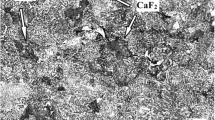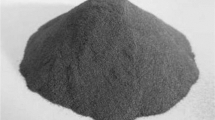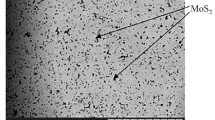The structure and antifriction properties acquired by a new composite produced from ShKh15SG structural steel grinding waste with additions of CaF2 solid lubricant are examined. The material is intended to operate at 300–400°C under loads of 5.0–7.0 MPa in air. Analysis of the secondary structures and antifriction properties shows that contact surfaces of the test material and counterface are covered with continuous antiseize friction films in the operating conditions in question. They contain chemical elements of both the composite and the counterface, as well as calcium fluoride. Oxygen is also present in the friction films as it participates in their development, entering into chemical reactions with the contacting elements to form various oxides and promote oxidative wear. The antifriction ShKh15SG + 5.0–7.0% CaF2 composite can be effectively used in friction units intended to operate in self-lubrication conditions at 300–400°C under loads of 5.0–7.0 MPa in air. In these operating conditions, the wear rate of the self-lubricating films that form on friction surfaces is balanced by their recovery rate. This is confirmed by high tribological properties. Recovered industrial grinding waste of structural steels is shown to be promising as a metal matrix to make high-quality antifriction composites for specific operating conditions. The structure and properties of the composites can be controlled by choosing the chemical composition of grinding waste and applying optimized manufacturing modes.



Similar content being viewed by others
References
P.O. Kirichok, T.A. Roik, A.P. Gavrysh, A.V. Shevchuk, and Iu.Iu. Vitsiuk, Novel Composite Materials for Friction Parts of Printing Machines [in Ukrainian], NTUU KPI, Kyiv (2015), p. 428.
T.A. Roik, P.O. Kirichok, and A.P. Gavrysh, Composite Bearing Materials for Harsh Operating Conditions [in Ukrainian], NTUU KPI, Kyiv (2007), p. 404.
T.A. Roik, O.A. Gavrysh, and Iu.Iu. Vitsiuk, “Wear-resistant composite material,” Ukrainian Patent 122870, IPC CС22C 21/02 (2006.01); appl. No. u201708942, September 8, 2017; publ. January 25 (2018), Bulletin No. 2, p. 4.
T. Roik, O. Gavrish, V. Oliynik, and Iu. Vitsiuk, “Analysis of the properties of antifriction composites based on aluminum alloy’s grinding waste,” East. Eur. J. Enterp. Technol., Issue 4/12 (94), 16–22 (2018).
T.A. Roik, Iu.Iu. Vitsiuk, and O.I. Khmiliarchuk, “Structurization and properties of antifriction composite materials made of recovered waste for printing machines,” Nauk. Visti KPI, No. 5, 50–57 (2018).
I.M. Fedorchenko and L.I. Pugina, Sintered Antifriction Composite Materials [in Russian], Naukova Dumka, Kyiv (1980), p. 404.
T.A. Roik, A.P. Gavrish, P.A. Kyrychok, and Iu.Iu. Vitsiuk, “Effect of secondary structures on the functional properties of high-speed sintered bearings for printing machines,” Powder Metall. Met. Ceram., 54, No. 1–2, 119–127 (2015).
A.G. Kostornov, Tribotechnical Materials Science [in Russian], Knowledge, Lugansk (2012), p. 696.
V.D. Zozulia, Lubricants for Sintered Self-Lubricating Bearings [in Russian], Naukova Dumka, Kyiv (1976), p. 191.
D. Jianxin and C. Tongkun, “Self-lubricant mechanisms via the in situ formed tribofilm of sintered ceramics with CaF2 additions when sliding against hardened steel,” J. Refract. Met. Hard Mater., No. 2, 189–197 (2007).
K. Jamroziak and T. Roik, “Structure and properties of the new antifriction composite materials for high-temperature friction units,” in: M. Abdel Wahab (ed.), Proc. 7th Int. Conf. Fracture Fatigue and Wear, FFW-2018, Book ID: 459769_1_En., Chapter No: 57, Lecture Notes in Mechanical Engineering, Springer, Singapore (2019), pp. 628–637.
K. Jamroziak, T. Roik, O. Gavrish, Iu. Vitsiuk, G. Lesiuk, Jose A.F.O. Correia, and A. De Jesus, “Improved manufacturing performance of new antifriction composite parts based on copper,” Eng. Fail. Anal., 91, 225–233 (2018).
T.A. Roik and Iu.Iu. Vitsiuk, “Effective antifriction composite materials made of ShKh15SG steel grinding waste for moderate operating conditions,” Nauk. Not., No. 61, 198–203 (2018).
A.I. Samokhotski, M.N. Kuniavski, T.M. Kuniavska, and N.G. Parfenovska, Physical Metallurgy [in Russian], Metallurgiya, Moscow (1990), p. 416.
V.N. Antsiferov, B.N. Akimenko, and L.M. Grevnov, Doped Powder Steels [in Russian], Metallurgiya, Moscow (1991), p. 318.
T. Wejrzanowski, “Computer program Micrometer,” Mater. Sci., No. 23, 28–34 (2005).
A.G. Stromberg, Synergy. Application to Chemical Processes [in Russian], Izd. Tomsk. Politekh. Univ., Tomsk (2000), p. 32.
V.P. Milovanov, Synergy and Self-Organization. Economics. Biophysics [in Russian], KomKniga, Moscow (2005), p. 168.
R.F. Voitovich and E.A. Pugach, Oxidation of Refractory Compounds [in Russian], Metallurgiya, Moscow (1978), p. 108.
Author information
Authors and Affiliations
Corresponding author
Additional information
Translated from Poroshkova Metallurgiya, Vol. 58, Nos. 7–8 (528), pp. 88–97, 2019.
Rights and permissions
About this article
Cite this article
Roik, T.A., Gavrysh, O.A. & Vitsiuk, I.I. Tribotechnical Properties of Composite Materials Produced from ShKh15SG Steel Grinding Waste. Powder Metall Met Ceram 58, 439–445 (2019). https://doi.org/10.1007/s11106-019-00093-w
Received:
Published:
Issue Date:
DOI: https://doi.org/10.1007/s11106-019-00093-w




